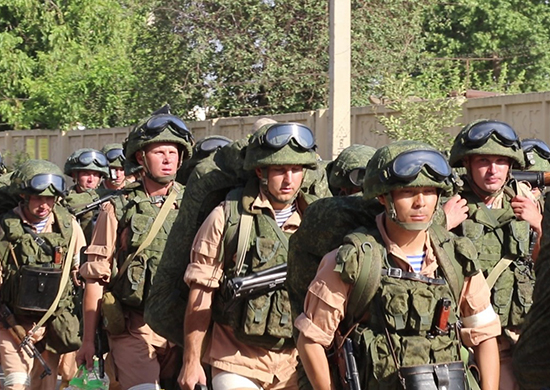
Russia, Tajikistan Conduct Joint Exercise in Badakhshan, Near Border With Afghanistan
Publication: Eurasia Daily Monitor Volume: 15 Issue: 110
By:

Tajikistan’s Armed Forces began a four-day joint training exercise, on July 17, with forces from Russia’s 201st military base, located on the territory of this Central Asian republic. Notably, the exercise, for the first time, took place along the Afghan border in Tajikistan’s mountainous eastern Gorno-Badakhshan Autonomous Region. Specifically, the drills were held at the Jilondi training range, 75 miles east of Khorugh. The press service of Russia’s Central Military District reported that 400 Russian service members and 700 Tajikistani reservists trained for how to counter the possible intrusion of militants from northern Afghanistan, eliminate indigenous extremist threats and organize territorial defenses (Mil.ru, July 17). The exercise concluded on July 21.
The Ministry of Defense of Tajikistan explicitly declared that the maneuvers were directed at countering possible threats emanating from Afghanistan: “The premise of the exercises is that numerous armed terrorist groups are trying to exit Afghanistan, with the possibility that some of the terrorists can break through. The task of the personnel participating in the exercises is both to repel attacks and eliminate the terrorists if they cross the frontier” (Regnum, July 16). Underscoring the importance of the exercise, the commander in charge was Lieutenant General Sherali Mirzo, Tajikistan’s minister of defense.
After the collapse of the Soviet Union in 1991, the Soviet Army’s 201st Motorized Rifle Division was placed under the command of the Soviet military’s successor, the Allied Forces of the Commonwealth of Independent States (CIS). While remaining mostly neutral in the violent 1992–1997 Tajik Civil War, the 201st Motorized Rifle Division was tasked with protecting critical local infrastructure sites, including the Nurek Hydropower Plant (which generated the majority of the country’s hydroelectric output), the Iavan electromechanical combine, the Vakhsh nitrogen fertilizer plant and a number of military facilities, along with several highways in the mountain passes in Kuliab and Kurgan-Tiubinskii provinces (Centrasia.ru, August 3, 2015).The 201st Motorized Rifle Division was reorganized in 2009 as the 201st Russian military base—currently, the largest military facility beyond Russia’s borders—with troops deployed between Dushanbe and Bokhtar. The 201st military base came under the direct control of the Armed Forces of the Russian Federation’s Central Military District. According to a 2012 bilateral government agreement signed between Tajikistan and Russia, Russian troops will remain at the base until 2042 (Fb.ru, September 10, 2017).
Even as Russian and Tajikistani troops undertake military exercises in Gorno-Badakhshan, concern about the militant threats emanating from Afghanistan’s neighboring Badakhshan province extends beyond Tajikistan. In March, the Afghan National Amy’s 209th Shaheen Military Corps said that its Kokcha-18 anti-terrorism operation, part of the countrywide “Grand Nasrat offensive,” resulted in the deaths of two Chinese citizens who were reportedly members of the East Turkestan Islamic Movement (ETIM). In all, seven militants were killed in Mirawab Raghak as a result of the engagement (Pajwok, March 31).
Beyond the Afghan Army’s ground operations in Badakhshan, rising militant activity there has invited increased offensive operations by the North Atlantic Treaty Organization (NATO). On February 7, United States Air Force Major General James B. Hecker, the commander of NATO Air Command Afghanistan, told reporters via satellite that US forces conducted air operations to strike Taliban and ETIM training facilities in Badakhshan. This was the first such aerial operation in the province, he noted, adding, “The destruction of these training facilities prevents terrorists from planning any acts near the border with China and Tajikistan. ETIM enjoys support from the Taliban in the mountains of Badakhshan, so hitting these Taliban training facilities and squeezing the Taliban’s support networks degrades ETIM capabilities” (Defense.gov, February 7). At the time of the Badakhshan airstrikes, according to the US Department of Defense, the Afghan Air Force conducted at least 40 airstrikes every week and the US Air Force carried out 25 airstrikes weekly (Tolo News, February 7).
Meanwhile, in a sign of growing trans-border cooperation, in June Afghanistan extradited to Tajikistan four Tajikistanis, arrested in the Afghan Badakhshan province town of Borak, opposite Darvaz District in Tajikistan’s Gorno-Badakhshan (Fergananews.com, June 28). The quartet had supported former Tajikistani minister of defense General Abduhalim Nazarzoda, who attempted a rebellion in September 2015 and was subsequently killed by Tajikistan’s security forces (see EDM, September 23, 2015). A number of Nazarzoda’s mutineer cohorts had consequently fled to Afghanistan.
Badakhshan is a vast, remote and rugged region that spans Afghanistan and Tajikistan. Today, it suffers from pervasive drug smuggling and heightened militant activity, making it among the most troubled of Afghanistan’s 34 provinces as well as a security concern to the central authorities in Dushanbe (see EDM, July 27, 2012). In light of the Afghan government’s struggle to quell unrest there on its side of the border, neighboring China and Tajikistan (the latter supported by Russia) are seeking to insulate themselves from the chaos spilling across the porous frontier. As there is little indication that Afghanistan will be pacified anytime soon, such measures will likely both continue and increase.
Failure to contain unrest there could have ominous implications beyond Central Asia; On June 1, Afghani Badakhshan police announced they arrested two men possessing a Stinger man-portable air-defense (MANPAD) system, “which they wanted to shift elsewhere” (Pajhwok.com, June 1). While military aircraft generally possess MANPAD countermeasures, civilian aircraft do not, adding a further element of urgency to pacification efforts in Afghanistan’s northeastern province. And since Badakhshan shares a southern border with Pakistan, also subject to extremist violence, immediate prospects for the province’s pacification seem slight, even as Afghanistan’s northern and eastern neighbors pursue increasingly aggressive defensive postures.



